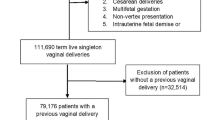Abstract
Background and aims
The objective of our study was to analyse the risk factors in a cohort of women who suffered anal sphincter disruption (third-degree tear) and compare the results with a similar cohort of women who underwent an uncomplicated vaginal delivery (without a clinically detectable laceration) during the same period.
Materials and methods
A retrospective analysis was carried out on 54 women (group 1) who suffered a third-degree tear and 71 women who had undergone uncomplicated vaginal delivery during the same period (group 2). The risk factors considered were forceps delivery, parity, second stage of labour longer than 1 h, episiotomy, birth weight over 4 kg, gestational age and maternal age at delivery. The Cleveland Incontinence Score was completed.
Results
Multiple logistic regression analysis of obstetric risk factors for third-degree perineal tear indicated forceps delivery (p = 0.0001), primiparity (p = 0.004), foetal birth weight over 4 kg (p = 0.030) and delay in the second stage of labour (p = 0.031) to be significant risk factors for a third-degree tear. Mediolateral episiotomy was shown to be a significant protective factor (p = 0.0001). Gestational age and the maternal age at delivery (p = 0.340) were not shown to be significant risk factors (p = 0.336).
Conclusion
Primary prevention and identification of women with risk factors is recommended. In some cases, counselling regarding the potential risks and benefits of both vaginal and caesarean delivery may be appropriate.

Similar content being viewed by others
References
Kamm MA (1994) Obstetric damage and faecal incontinence. Lancet 344(8924):730–733
Sultan AH, Kamm MA, Hudson CN, Thomas JM, Bartram CI (1993) Anal-sphincter disruption during vaginal delivery. N Engl J Med 329(26):1905–1911
Norton C,Christiansen J,Butler U, Harari D, Nelson RL, Pemberton J, Price K, Rovnor E, Sultan A (2002) Anal incontinence. Proceedings of the 2nd International Consultation on Incontinence, Paris
Sultan AH, Thakar R (2002) Lower genital tract and anal sphincter trauma. Best Pract Res Clin Obstet Gynaecol 16(1):99–115
Royal College of Obstetricians and Gynaecologists (2001) Management of third and fourth degree perineal tears following vaginal delivery. RCOG Guideline no. 29, pp 1–8
Ingraham HA, Gardner MM, Heus E (1949) Report on 159 third degree lacerations. Am J Obstet Gynecol 57:730–735
Barter RH, Parks J, Tyndal C (1960) Median episiotomies and complete perineal lacerations. Am J Obstet Gynecol 80:654–662
Roberts PL, Coller JA, Schoetz DJ Jr, Veidenheimer MC (1990) Manometric assessment of patients with obstetric injuries and fecal incontinence. Dis Colon Rectum 33(1):16–20
Haadem K, Ohrlander S, Lingman G (1998) Long-term ailments due to anal sphincter rupture caused by delivery—a hidden problem. Eur J Obstet Gynecol Reprod Biol 27(1):27–32
Coats PM, Chan KK, Wilkins M, Beard RJ (1980) A comparison between midline and mediolateral episiotomies. Br J Obstet Gynaecol 87(5):408–412
Oberwalder M, Connor J, Wexner SD (2003) Meta-analysis to determine the incidence of obstetric anal sphincter damage. Br J Surg 90(11):1333–1337
Thacker SB, Banta HD (1983) Benefits and risks of episiotomy: an interpretative review of the English language literature, 1860–1980. Obstet Gynecol Surv 38(6):322–338
Sultan AH, Kamm MA, Hudson CN, Bartram CI (1994) Third degree obstetric anal sphincter tears: risk factors and outcome of primary repair. BMJ 308(6933):887–891
Jorge JM, Wexner SD (1993) Etiology and management of fecal incontinence. Dis Colon Rectum 36(1):77–97
Walsh CJ, Mooney EF, Upton GJ, Motson RW (1996) Incidence of third-degree perineal tears in labour and outcome after primary repair. Br J Surg 83(2):218–221
Fenner DE, Genberg B, Brahma MPH, Marek L, DeLancey JOL (2003) Fecal and urinary incontinence after vaginal delivery with anal sphincter desruption in an obstetric unit in the United States. Am J Obstet Gynecol 189:1543–1550
Sultan AH, Kamm MA, Bartram CI, Hudson CN (1993) Anal sphincter trauma during instrumental delivery. Int J Gynaecol Obstet 43(3):263–270
de Leeuw JW, Struijk PC, Vierhout ME, Wallenburg HC (2001) Risk factors for third degree perineal ruptures during delivery. BJOG 108(4):383–387
Sleep J, Grant A, Garcia J, Elbourne D, Spencer J, Chalmers I (1984) West Berkshire perineal management trial. BMJ 289:587–590
Argentine Episiotomy Trial Collaborative Group (1993) Routine vs selective episiotomy: a randomised controlled trial. Lancet 342:1517–1518
Sangalli MR, Floris L, Faltin D, Weil A (2000) Anal incontinence in women with third or fourth degree perineal tears and subsequent vaginal deliveries. Aust N Z J Obstet Gynaecol 40(3):244–248
Pinta TM, Kylanpaa ML, Salmi TK, Teramo KA, Luukkonen PS (2004) Primary sphincter repair: are the results of the operation good enough? Dis Colon Rectum 47(1):18–23
Farrell SA (2002) Cesarean section versus forceps-assisted vaginal birth: it’s time to include pelvic injury in the risk–benefit equation. CMAJ 166(3):337–338
Acknowledgment
The authors wish to thank the Norfolk and Norwich Institute for Medical Education (NANIME) for funding the project.
Author information
Authors and Affiliations
Corresponding author
Rights and permissions
About this article
Cite this article
Samarasekera, D.N., Bekhit, M.T., Preston, J.P. et al. Risk factors for anal sphincter disruption during child birth. Langenbecks Arch Surg 394, 535–538 (2009). https://doi.org/10.1007/s00423-008-0441-0
Received:
Accepted:
Published:
Issue Date:
DOI: https://doi.org/10.1007/s00423-008-0441-0




